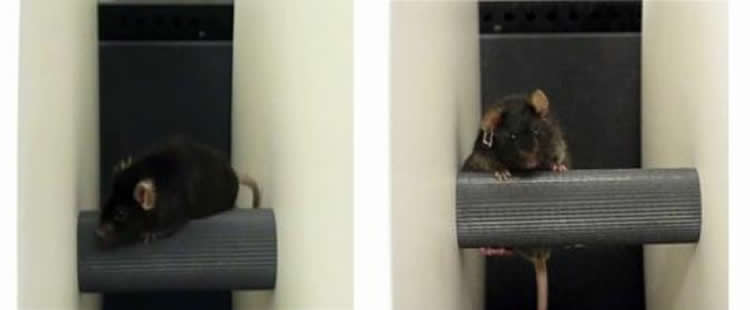Summary: A new study reports bone marrow transplants can significantly delay the onset of motor deficits in mouse models of MLIV.
Source: UC Santa Barbara.
Extending what they learned from flies to a mouse model, researchers discover a possible first therapy for an uncommon childhood disease.
Mucolipidosis IV (MLIV) is a devastating early childhood neurological disease characterized by progressive neurodegeneration, leading to severe impairments in muscle coordination, cognitive deficits and retinal degeneration that causes blindness.
There is no effective treatment for the condition, symptoms of which usually appear within a year of birth — and whose rarity makes it a low priority for pharmaceutical companies.
But a possible first therapy has been discovered by biologist Craig Montell and his team of scientists at UC Santa Barbara. In a new study, researchers in Montell’s lab found that bone marrow transplantation (BMT) significantly delayed the onset of motor deficits in an MLIV mouse model. Their findings appear in the journal Human Molecular Genetics.
MLIV is caused by mutations that eliminate the TRPML1 protein. TRPML1 is needed in small packages of the cell known as lysosomes, which are required for breaking down cellular components. Loss of TRPML1 causes the death of neurons.
“The idea to try bone marrow transplantation came out of our earlier fruit fly model for MLIV,” said senior author Montell, the Robert and Patricia Duggan Chair in Mathematical, Life, and Physical Sciences in UCSB’s Department of Molecular, Cellular, and Developmental Biology. “Surprisingly, we found that the fly version of the TRPML1 protein was required not only in neurons but also in cells in the nervous system called glia, which eat up dying neurons.”
This process is called phagocytosis. In mammals, phagocytic brain cells — called microglia — provide an important protective mechanism by disposing of dying neurons. If that doesn’t happen, those neurons remain and release toxic agents that promote the rapid death of neighboring cells.
This amplification fosters disease progression in MLIV but has been shown to be greatly reduced in a fly model by restoring normal phagocytic glia. “Because TRPML1 is also required in microglia, and normal microglia will get into the brain following BMT, we tried this approach in a mouse MLIV model,” Montell said.
The work was carried out in the mouse by lead author Marquis Walker, a postdoctoral researcher in Montell’s lab. “When the BMT was performed on really young mice, the approach greatly delayed the onset of motor problems,” he said.
To test the rodents’ motor skills, the researchers used a rotorod assay. They placed normal and MLIV mice on a spinning rod and measured how long they were able to remain in position. The rotation speed started at 5 revolutions per minute and increased 1 rpm every 5 seconds.

At all ages, the normal mice stayed on the rotorod for about 2 minutes. For MLIV mice, age affected the length of time they were able to hang on. At 6 weeks, the mutant animals were already performing below the level of normal mice. They became progressively compromised and by 32 weeks were unable to stay on the rod.
“This work shows that BMT prevented the amplification process, which in turn delayed the degradation of motor skills,” Montell said. Bone marrow transplantation had been tried for other lysosomal storage disorders for enzyme replacement, he noted, but had not previously been considered for MLIV since the problem was with the TRPML1 channel protein rather than with lysosomal enzymes.
“This is not the end of the story,” Montell added. “While this latest work suggests a potential therapy, more research needs to be done. The next step would be to use an MLIV mouse model to determine how certain drugs or amino acid supplementation — both of which have shown some promise — work in combination with BMT.”
Source: Julie Cohen – UC Santa Barbara
Image Source: This NeuroscienceNews.com image is credited to UCSB.
Original Research: Abstract for “Suppression of the motor deficit in a mucolipidosis type IV mouse model by bone marrow transplantation” by Marquis T. Walker and Craig Montell in Human Molecular Genetics. Published online June 7 2016 doi:10.1093/hmg/ddw132
[cbtabs][cbtab title=”MLA”]UC Santa Barbara. “Possible New Therapy for a Rare Childhood Disease.” NeuroscienceNews. NeuroscienceNews, 28 June 2016.
<https://neurosciencenews.com/mliv-fruit-fly-neurology-4591/>.[/cbtab][cbtab title=”APA”]UC Santa Barbara. (2016, June 28). Possible New Therapy for a Rare Childhood Disease. NeuroscienceNew. Retrieved June 28, 2016 from https://neurosciencenews.com/mliv-fruit-fly-neurology-4591/[/cbtab][cbtab title=”Chicago”]UC Santa Barbara. “Possible New Therapy for a Rare Childhood Disease.” https://neurosciencenews.com/mliv-fruit-fly-neurology-4591/ (accessed June 28, 2016).[/cbtab][/cbtabs]
Abstract
Suppression of the motor deficit in a mucolipidosis type IV mouse model by bone marrow transplantation
Mucolipidosis IV (MLIV) is a severe lysosomal storage disorder, which results from loss of the TRPML1 channel. MLIV causes multiple impairments in young children, including severe motor deficits. Currently, there is no effective treatment. Using a Drosophila MLIV model, we showed previously that introduction of trpml+ in phagocytic glia rescued the locomotor deficit by removing early dying neurons, thereby preventing amplification of neuronal death from cytotoxicity. Because microglia, which are phagocytic cells in the mammalian brain, are bone marrow derived, and cross the blood–brain barrier, we used a mouse MLIV model to test the efficacy of bone marrow transplantation (BMT). We found that BMT suppressed the reduced myelination and the increased caspase-3 activity due to loss of TRPML1. Using a rotarod test, we demonstrated that early BMT greatly delayed the motor impairment in the mutant mice. These data offer the possibility that BMT might provide the first therapy for MLIV.
“Suppression of the motor deficit in a mucolipidosis type IV mouse model by bone marrow transplantation” by Marquis T. Walker and Craig Montell in Human Molecular Genetics. Published online June 7 2016 doi:10.1093/hmg/ddw132






